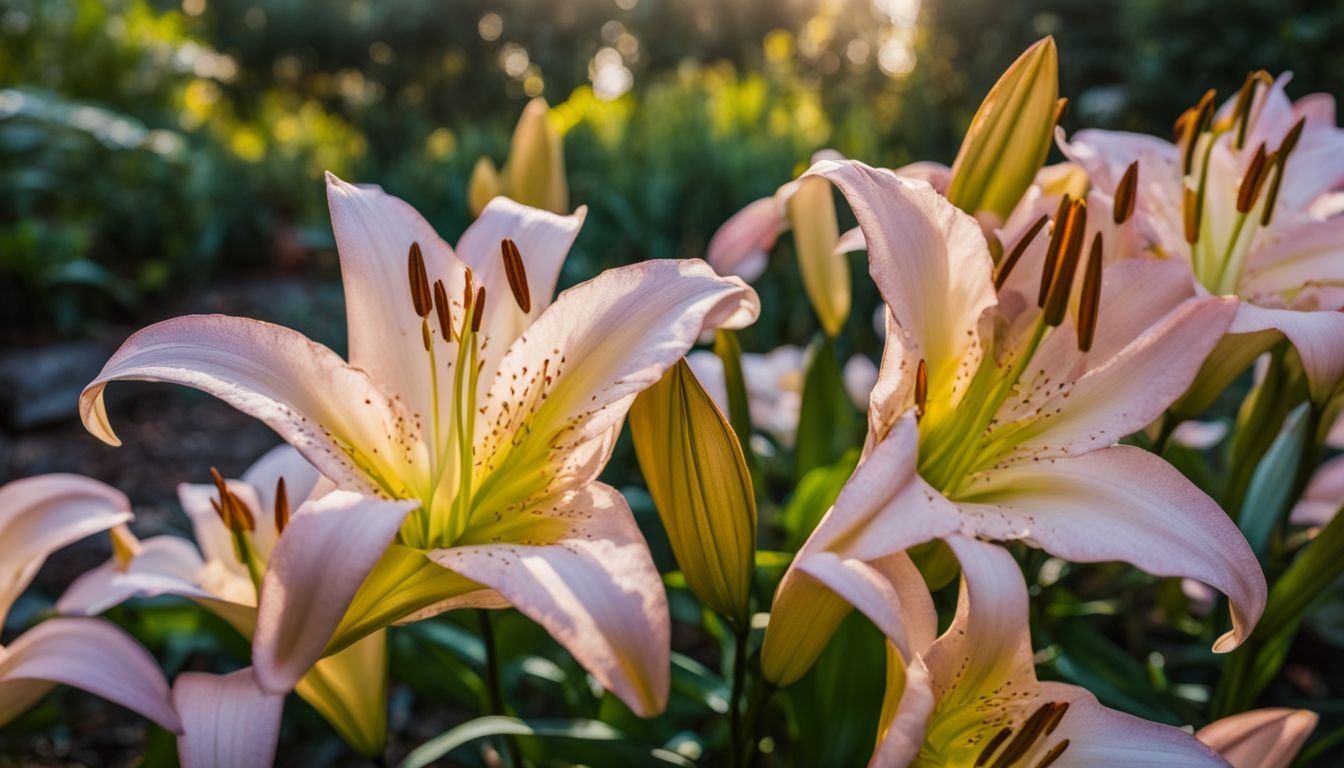Gardening down under comes with its very own set of quirks and delights, especially when the goal is to cultivate a batch of stunning flowers. Who wouldn’t want the breathtaking November Lily, with its creamy-white, trumpet-shaped beauties adorning their backyard? Yet, cracking the code on growing these or other splendid bulbous plants in our Aussie gardens can feel like you’re trying to solve a puzzle.
And trust me, it’s not just you finding it a tad challenging – we’ve all been through our fair share of gardening hiccups.
In pursuit of turning our green thumbs even greener, we plunged into a deep pool of research and unearthed some game-changing tidbits. For example, were you across the fact that the November Lily (Lilium longiflorum), affectionately known as the Christmas lily in some parts, truly comes into its own when planted in conditions that closely resemble their natural digs? With this nugget and more up our sleeve, we’ve knocked together a guide aimed at helping fellow Australian flora aficionados.
This yarn spans from picking out just the right soil mix to getting your head around how often your November Lilies need a drink. We’ll shepherd you through every step – planting to care – ensuring your perennials reach their full glory.
Keen for blooms that’ll be the envy of your neighbours?
Key Takeaways
- November Lilies, also known as Christmas or Easter lilies, love well – drained soil that’s slightly acidic and rich in organic matter like compost or aged manure.
- They grow best in cool climate zones, enjoying spots with morning sun and afternoon shade to protect their delicate blooms from harsh Australian sun.
- Plant Lilium longiflorum bulbs in late winter or early spring about 15 – 20 cm deep and 30 cm apart to prevent overcrowding and ensure optimal growth.
- Keep the soil moist but not soggy by watering regularly. Apply mulch to retain moisture and keep the roots cool. Use slow-release fertiliser at the start of spring and again when flowering begins for vibrant blooms.
- Watch out for common issues such as overwatering indicated by yellow leaves, too much direct sunlight causing brown tips on leaves, stunted growth from nutrient-poor soil, mould from high humidity, damage from pests like snails or slugs, and wilted flowers due to extreme heat or insufficient water.
Understanding the Growth Requirements of November Lilies

To grow November Lilies well, we need to know what they love. They thrive in soil that drains well and crave a spot that gets gentle sun in the morning but stays cool in the afternoon.
Ideal soil conditions
For our November Lilies, or Easter lily as some call them, getting the soil just right makes all the difference. They thrive in well-drained, friable earth that’s slightly acidic and rich in organic matter – think compost or aged manure to give them a good start.
Ensuring this kind of environment helps these perennial plants put down roots in a place they love, setting the stage for those waxy white trumpet-shaped flowers we’re all aiming for.
We also need to talk about feeding our lilies. A bit of fertilisation goes a long way, especially during their active growth periods. This nourishment is crucial for encouraging lively blooms that make Oriental and Asiatic varieties stand out as excellent cut flowers.
Remembering to mulch helps keep their roots cool and comfy, which is essential under our sun-soaked skies. And if your garden tends toward the shady side, consider adding stakes to keep your lilies standing tall and proud.
Now that we’ve got our soil sorted, let’s look into ensuring our climate suits these beauties just as well.
Suitable climate
After digging into the ideal soil conditions for our November Lilies, let’s shift our focus to another crucial aspect: the climate they thrive in. For these lilies, known as Longiflorum or Christmas Lilies, a cool climate zone suits them best.
They prefer not to swelter under harsh Australian summer suns but rather enjoy cooler spots that mimic their native environments.
These flowers are quite particular about where they flourish. The Lilium ‘November Rain’ variety especially thrives when planted in an area that receives gentle morning sunlight yet is shielded from intense afternoon rays.
This balance ensures their delicate waxy white trumpet-shaped blooms don’t suffer from heat stress but still get enough light to grow strong and vibrant.
“To see a world in a grain of sand and heaven in a wildflower.”
Watering and sunlight needs
November Lily flowers thrive best in spots where they can soak up the sun for most of the day but also enjoy a bit of shade. This balance ensures they bloom beautifully, showing off their waxy white trumpet-shaped blossoms.
We always aim to find that perfect sunny spot in our gardens, knowing it encourages strong growth and vibrant flowers.
Water plays a crucial role too, especially as these lilies prepare to flower. Giving them enough water during this time supports their development and leads to those stunning blooms we all love.
It’s good practice to keep an eye on moisture levels in the soil, ensuring it never gets too dry. Mulching helps a lot with this by keeping the soil cool and moist longer, making our watering efforts more efficient.
Step-by-Step Guide to Planting and Caring for November Lilies

Planting and caring for November Lilies in Australia bring joy and vibrant colours to our gardens. These steps show how easy it is to grow these beautiful flowers.
- Choose the right spot: November Lilies thrive in a place where they get morning sun and afternoon shade. The ideal location protects them from the hottest part of the day.
- Prepare your soil: These lilies love well-draining soil. Mix in some compost or manure to give them a good start.
- Plant the bulbs: In late winter or early spring, plant your Lilium longiflorum bulbs about 15-20 cm deep and 30 cm apart. This spacing helps avoid overcrowding as they grow.
- Water them well: After planting, give your lilies plenty of water. They need moist, but not soggy, soil to flourish.
- Apply mulch: Putting mulch around your plants keeps the moisture in and weeds out. It also keeps the soil temperature stable.
- Use fertiliser wisely: Feed your Asiatic or Oriental lilies with a slow-release fertiliser at the start of spring and again as they begin to flower for maximum growth.
- Monitor for pests: Keep an eye out for snails, slugs, and aphids that might harm your plants. Use environmentally friendly options to keep these pests away.
- Water regularly but don’t overdo it: During hot summers, these hardy flowers still need consistent watering but ensure good drainage to prevent root rot.
- Stake tall varieties: Some November Lilies can get quite tall and might need staking to support their weight, especially in windy areas.
- Watch for flowering: Expect waxy white trumpet-shaped flowers about 17 weeks after planting if you’re in a cool climate zone.
By following these steps closely, we create an ideal environment for our November Lilies to thrive and beautify our gardens throughout the Australian summer with minimal trouble.
Troubleshooting Common Issues in Growing November Lilies
Growing November Lilies in Australia can sometimes face hurdles. We’ll guide you through overcoming some common problems to keep your Asiatic lilies thriving.
- Yellow leaves often indicate over – watering. Make sure the soil drains well and reduce how much water you give.
- Brown tips on leaves suggest too much direct sunlight. Move your plants to a spot where they get filtered light, particularly during the hottest part of the day.
- Stunted growth can be a sign of nutrient-poor soil. Mix in compost or a general-purpose fertiliser to feed your lilies.
- If you spot mould or mildew, it means too much humidity. Improve air circulation around your plants and avoid wetting the foliage when watering.
- Chewed leaves are usually the work of pests like snails or slugs. Use traps or barriers to keep these critters at bay.
- Wilted flowers before their time could be from lack of water or extreme heat. Water deeply during dry spells and provide some shade with garden fabric if temperatures soar.
Dealing with these challenges will help ensure your waxy white trumpet-shaped flowers bloom beautifully throughout their season.
Conclusion: Enjoying the Beauty of November Lilies in Your Australian Garden
Growing November Lilies brings a touch of elegance to Australian gardens. These waxy white trumpet-shaped blooms turn heads and fill the air with their sweet scent. Getting them in the soil at the right time ensures they light up your garden just when you want them to.
With proper care, these flowers thrive, adding charm and tranquility to any space. So, plant some November Lilies today, and watch your garden transform into a fragrant paradise that enchants everyone who visits.
FAQs
1. What are November Lily flowers?
November Lily flowers, known scientifically as Lillium longiflorum, are beautiful plants with waxy white trumpet-shaped flowers.
2. Can I grow November Lily in Australia?
Yes, you can grow November Lily in Australia. These flowers thrive well in the Australian climate and add beauty to gardens with their elegant blooms.
3. What family do November Lilies belong to?
November Lilies are part of the Liliaceae family, which is known for its diverse and colorful flowering plants.
4. How should I care for my November Lily plants?
To care for your November Lily plants, ensure they receive enough sunlight, water them regularly but avoid overwatering, and plant them in well-draining soil for best growth results.
